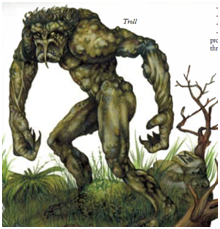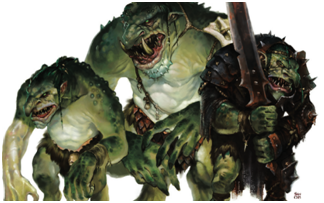One of my favorite creatures for use RPGs is the troll. Everyone interprets them differently, from the intelligent, to the more fae, to the savage. Some split them into groups, like Mountain and Woodland (like the movie Troll Hunter), or Mountain and River (like is common around some rpg bestiaries). In any manner, you can do a lot with trolls to keep players on their feet.
The traditional RPG troll is a 7-9 foot creature with great rending claws and the ability to regenerate any and all damage except damage by fire and acid.
Let’s take a look at RPG troll options through the variations of D&D and some other games.
Original Dungeons and Dragons:
| Monster Type | # Appearing | AC | Move in inches | Hit Dice | % in lair | Treasure Type |
| Trolls | 2-12 | 4 | 12 | 6+3 | 50% | Type D |
| Gnoll | 20-200 | 5 | 9 | 1+1/2 | 30% | Type D |
“TROLLS: Thin and rubbery, loathsome Trolls are able to regenerate, so that beginning the third melee round after one is hit it will begin to repair itself. Regeneration is at the rate of 3 hit points per turn. Even totally sundered Trolls will regenerate eventually, so that unless they are burned or immersed in acid they will resume combat when they have regenerated to 6 or more hit points. In strength they are about equal to an Ogre, but as they use only their talons and fangs for weapons, only one die of damage is scored when they hit an opponent.”
Meanwhile we have the first variation of a troll: the gnoll. In the original edition of Dungeons and Dragons, the Gnoll was a combination of Gnome and Troll, but it was listed in the chart alongside Orcs and Hobgoblins, implying it was far weaker and expected to be faced as a large group (similar to its list-mates).
“GNOLLS: A cross between Gnomes and Trolls (. . . perhaps, Lord Sunsany did not really make it all that clear) with +2 morale. Otherwise they are similar to Hobgoblins, although the Gnoll king and his bodyguard of from
1 – 4 will fight as Trolls but lack regenerative power.”
In Holmes Basic we have a singular Troll entry. They’re officially classed as chaotic evil and regenerate at a rate of 3 damage per turn. They are noted as having the strength of Ogres, but “attack with talons and fangs” instead for some strange reason.
In Moldvay Expert rules, trolls are officially sized at “nearly 8′ tall”. The number appearing is reduced to 1-8 and are listed as intelligent and preferring humanoid flesh over any other. They are listed as living in “caves, dungeons, wastelands, and in ruined dwellings of the humanoids they have slain and eaten.”
In First Edition the troll goes back to its original number appearing of 2-12 and their size is increased to Large (9′ + tall).
“Description: Troll hide is a nauseating moss green, mottled green and gray, or putrid gray. The writhing hair-like growth upon a troll’s head is greenish black or iron gray. The eyes of a troll are dull black.”
In Second Edition we finally begin to see variations of the troll. We have the default troll, the two-headed troll, freshwater troll (scrag), saltwater troll (marine scrag), desert, spectral (troll wraith), giant, and ice, and spirit. Second Edition is where we very much see the naturalism involved with later D&D with the ecology details and such for the troll entry.

In 3.5 edition we are told an adult troll stands 9 feet tall and weighs around 500 pounds, and that trolls speak Giant (where earlier editions claimed they spoke their own language, trollish). The Scrag is retained, and we are given a new “class” of troll, titled the Troll Hunter, which is a more cunning troll that hunts intelligent humanoids for kicks and food and is trained as a ranger. There are also rules given for playing a troll for your race as a player character.

In Fourth Edition we are given some new troll stat blocks. We have the default troll, the extra powerful, greatsword-wielding War Troll, and the unnecessarily large Fell Troll.

And finally, Shadowrun 4th where they are a variant of the magically changed humans, being two and a half meters tall and 300 to 350 kg and have long horns which grow in all sorts of manners. They are, as always, huge and intimidating and have tough, armor-like skin. No regeneration here, however.
Now let’s look into Folklore: (via the ever-present Wikipedia)
In Norse mythology, troll was used as a derogatory term for jötunn, or giant.
“There is much confusion and overlap in the use of Old Norse terms jötunn, troll, þurs and risi. Lotte Motz theorized that these were originally four distinct classes of beings; lords of nature (jötunn), mythical magicians (troll), hostile monsters (þurs) and heroic and courtly beings (risi) – the last class being the youngest addition.” While this is considered an unsupported theory, this does give us some room for creating trolls in RPGs. Risi could be interpreted as the Fae variants of the troll, Jötunn being the intelligent, enormous mountain trolls, Troll (though probably with a new name) could easily be troll-witches in the wilderness, and þurs being the more savage trolls of the wilderness.
Interestingly enough, most RPGs ignore the traditional concepts of trolls turning to stone when they come into contact with sunlight and the rumors that lightning scares them away.
In Scandinavian folklore, we are given details of different troll types (straight out of Wikipedia, because… well I’m lazy at times).
“…Troll or Trold can also be used for smaller creatures, which are said to live underground, in burial mounds and in the mountains. These trolls appear to be from mixture of different tales about creatures from old Norse myth, such as the Alfar (Elves), Dvergar (Dwarves) and spirits of the dead. These creatures are called Troldfolk, Bjerg-trolds or Bjergfolk in Denmark and Troldfolk or Tusser in Norway. They are linked with the Norse concept of the Vættir and Landvættir, which mean “Spirits” and “Land spirits” of various kinds. These creatures appear as small human like beings or as tall as men.
In some districts these trolls differ but little from the Huldrefolk who are grotesque creatures, with long noses or cows’ tails. Like these trolls they could be the same size as humans and sometimes small. They can also be dangerous to human. This possession of a tail is similar to that of the Huldra who could be seen as the queen of the huldrefolk.
In Norwegian tradition a line of distinction is drawn between the trolls and the huldrefolk, but whether the trolls and huldrefolk came from the same stock or had different origins altogether is still unanswered. However, the use of trow in Orkney and Shetland to mean something very like the “family” of beings covered by the huldrefolk in Norway suggests that they may come from the same stock”

(from Wikipedia)
Now let’s look at Swords and Wizardry:
Troll: HD 6+3; AC 4[15]; Atk 2 claws (1d4), 1 bite (1d8); Move 12; Save 11; CL/XP 8/800; Special: Regenerate 3hp/round.
“Trolls are as tall as ogres, and just as strong. Unlike ogres, however, they attack with claws and teeth instead of weapons. Trolls regenerate, which is to say that any damage inflicted upon them heals within minutes
(3 hit points per round). The only way to utterly kill a troll is to submerse it in acid or burn it. Trolls can even re-grow lopped-off heads and limbs.”
This gives us the basic troll, what I will denote as a “True Troll”. Now let’s take this and make some simple statistics for troll variants.
Jotunn: HD 8+3; AC 3[16]; Atk 2 claws (1d8), 1 bite (1d12); Move 14; Save 8; CL/XP 10/1400; Special: Regenerate 3hp/round.
Jotunn are massive mountain trolls with human intelligence. They stand around 30 to 54 feet tall are usually quite territorial (as they need quite a lot of food to themselves). They regenerate as any other troll, but due to their size causes them to become even hungrier than normal. If they had to regenerate three times in one battle to reach max HP and they deem the enemy to be worthless, they will abandon the battle to search for food that has less point weapons. They more often than only wander out at night; while sunlight does not kill them or turn them to stone, it does heavily annoy them to where they will be at -5 to hit in sunlight.
Ringlefinch: HD 6+3; AC 3[16]; Atk 2 claws (1d6), 1 bite (1d10); Move 10; Save 11; CL/XP 9/1100; Special: Disease, Immune to Blunt/Piercing Weapons, Swallow Whole
Ringlefinch trolls are large, muscular beasts that stand around 12-14 feet tall and lack the regenerative qualities of “True Trolls”, but have a multiple chunks of calcium build ups all over their bodies and thick moss growth that protects them from many weapons. They are filthy, often living in stagnant ponds and nearby caves and tend to contract diseases. They are highly unintelligent, their only motivation being hunger, and will attempt to swallow an enemy whole if they hit with both claws. If they succeed, the troll regains 5 hit points. Ringlefinch only hunt at night, as sunlight fully calcifies them. They are deathly afraid of lightning and will not wander out during stormy nights.
Bjergtrold: HD 4+4; AC 6[13]; Atk 2 claws (1d6), Staff (1d6); Move 10; Save 13; CL/XP 6/400; Special: Casts spells like an 8th level Magic-User
Bjergtrold, or Troll-Witches, are trollkin witches, often gathered in covens with hags or other witches. They are immensely powerful magic casters, but otherwise rather weak. They are built like traditional trolls but lack their regenerative powers. They are not affected by sunlight, but prefer not to be in it. They do, however, still retain the vicious claws and ugly appearance of their forbearers.
Risi: HD: 5+2; AC 6[13]; Atk rapier (1d6); Move: 12/20 (flying); Save 12; CL/XP 9 ; Special: Flight, Resistance to Magic 25%, Immune to Non-Magical Weapons, Regenerate 1hp/round
Risi are a variant of troll that belong to the “True Fae”. Tied to the concepts of Magic and Nature, Risi are 9 foot chaotic beings of mercurial disposition. Risi belong to the Fae Court of Summer and often dress in mockeries of human noble clothing and wear a rapier at their sides. They can fly by magical means and can turn invisible at will, but are unable to change their size. The sounds of bells repel them, as well as bread of any sort, both of which symbolize stability and humanity. Despite being True Fae, they look entirely like True Trolls in noble clothing. They will never use their claws unless entirely desperate.
You can do a lot with trolls in a game to keep your players on their toes. Removing their weaknesses, or simply changing them to something else, will throw metagamers off quite a lot. Losing regeneration and giving them other powers instead let’s you confuse them even more. Combine these into making a troll that doesn’t regenerate unless it is covered in fire or acid and is immune to magic is just absurd. Either way, trolls are a good monster to throw at a party of early-mid level characters. They can be members of a group of other monsters (0e gnolls perhaps? Ha!) or singular entities ravaging the fields for sheep or any number of things.

